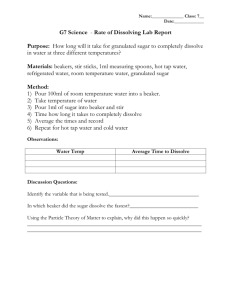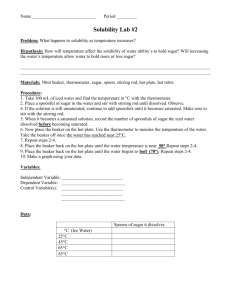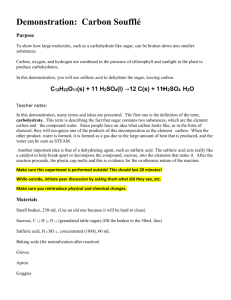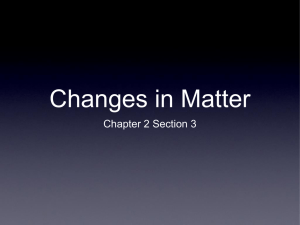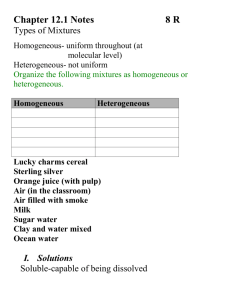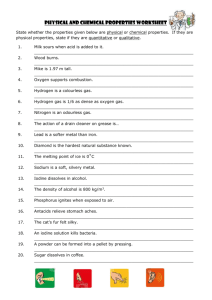CHEMISTRY CONCEPT INVENTORY TEST
advertisement
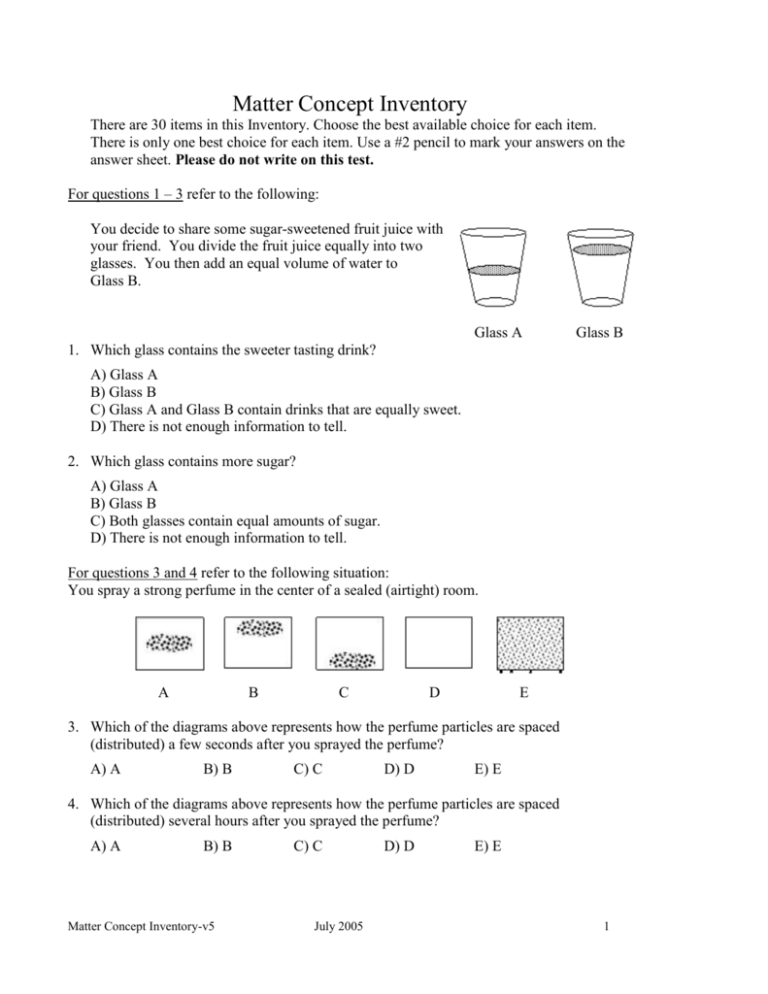
Matter Concept Inventory There are 30 items in this Inventory. Choose the best available choice for each item. There is only one best choice for each item. Use a #2 pencil to mark your answers on the answer sheet. Please do not write on this test. For questions 1 – 3 refer to the following: You decide to share some sugar-sweetened fruit juice with your friend. You divide the fruit juice equally into two glasses. You then add an equal volume of water to Glass B. Glass A Glass B 1. Which glass contains the sweeter tasting drink? A) Glass A B) Glass B C) Glass A and Glass B contain drinks that are equally sweet. D) There is not enough information to tell. 2. Which glass contains more sugar? A) Glass A B) Glass B C) Both glasses contain equal amounts of sugar. D) There is not enough information to tell. For questions 3 and 4 refer to the following situation: You spray a strong perfume in the center of a sealed (airtight) room. A B C D E 3. Which of the diagrams above represents how the perfume particles are spaced (distributed) a few seconds after you sprayed the perfume? A) A B) B C) C D) D E) E 4. Which of the diagrams above represents how the perfume particles are spaced (distributed) several hours after you sprayed the perfume? A) A B) B Matter Concept Inventory-v5 C) C July 2005 D) D E) E 1 For questions 5 & 6 refer to the following: The evening before a birthday party, you fill several balloons with helium gas. The birthday party occurs on a hot summer day. 5. The next day (the same hot temperature) the latex balloons are noticeably smaller. Which of the following explains this observation? A) Some of the helium particles escaped through pores in the latex. B) The helium particles became smaller than before. C) The helium particles lost their strength. D) The particles moved closer to each other. 6. A guest at the party dives into the swimming pool holding an inflated balloon. The balloon gets smaller when she dives to the bottom of the pool. Which of the following explains this observation? A) Some of the helium particles escaped through pores in the latex. B) The helium particles became smaller than before. C) The helium particles lost their strength. D) The particles moved closer to each other. 7. You have one of those steel tanks that scuba divers use for breathing. Your scientist friend pumps out all the air; then you weigh the empty tank. After that, he pumps air into the tank, and then you weigh it again. How does the weight of the tank and air compare to the weight of the empty tank? A) The tank that contains the air weighs more. B) The tank that contains the air weighs less. C) The tank with air weighs the same as the empty tank. For questions 8 - 10 refer to the following: Two cups contain equal amounts (250 g) of coffee; one is cold, the other is hot. You add 10 g of sugar to each cup and stir. 8. What is the mass of the contents of each of the cups? A) B) C) D) 250 g somewhere between 250 g and 260 g 260 g somewhat more than 260 g Matter Concept Inventory-v5 July 2005 2 9. What happens to the sugar particles when you add them to each of the cups of coffee? A) They cease to exist. B) They spread out through the coffee. C) They become liquid. D) They form a new and different type of substance with the coffee. 10. Why does the sugar dissolve faster in the hot coffee? A) B) C) D) The sugar particles cease to exist faster when in a hot liquid. The particles of hot liquid bump into the sugar particles more often. The sugar becomes a liquid faster in a hot liquid. The sugar forms a new substance faster in a hot liquid. For questions 11 & 12 refer to the following: You put the same amount of water at room temperature into three beakers of equal size. Then you add the same mass of sugar to each beaker, but you add it in these different forms: a cube of sugar into beaker A, granulated sugar into beaker B, and powdered sugar into beaker C. Sugar cube added A Granulated sugar added B Powdered sugar added C 11. In which beaker will the sugar dissolve most rapidly? A) A B) B C) C D) The sugar will finish dissolving at the same time in all 3 beakers. 12. After all the sugar is dissolved in each beaker, you let the water totally evaporate very slowly. What is left in each beaker? A) Nothing. B) A sugar cube in beaker A, granulated sugar in beaker B, and powdered sugar in beaker C. C) Beaker A contains more sugar than either beaker B or beaker C. D) An equal mass of crystalline sugar will be left in each beaker. E) Beaker C contains more sugar than either beaker A or beaker B. Matter Concept Inventory-v5 July 2005 3 13. A glass half-full of room temperature water is on a table. You add some ice cubes to the water. Very soon, droplets appear on the outside surface of the glass. Where do the droplets come from? A) B) C) D) Water came through the glass from the inside. Liquid seeped out of the glass itself. The droplets came from the air. The droplets came from the table. 14. How are the droplets on the glass formed? A) Water seeped through the glass from the inside. B) They were squeezed from the glass. C) They condensed from the air. D) They are extracted out of the table. 15. You dampen a tissue and put it into a jar. You close the lid tightly and set it in the sun. After a while you notice that the jar looks kind of cloudy, and small water droplets are on the inside of the jar. What has happened to the mass of the tissue/jar system? A) B) C) D) The mass has increased The mass has decreased The mass has not changed The mass could increase or decrease depending on the type of liquid. 16. You heat water on your kitchen stove until it boils. While the water is boiling, the temperature of the water … A) increases. B) decreases. C) does not change D) increases and decreases periodically (that is, back and forth). 17. The bubbles that form when the water boils … A) contain nothing. B) are bigger water particles. C) are air bubbles. D) are water vapor. E ) contain hydrogen gas and oxygen gas. 18. You add several ice cubes to a mug of hot tea. After ten minutes, you notice that half of the ice remains and the ice is no longer melting. The temperature of the tea now is A) higher than the temperature of the ice. B) lower than that of the ice. C) the same as that of the ice. D) It is impossible to tell. Matter Concept Inventory-v5 July 2005 4 The diagram below shows two sealed containers, each containing 25 g of a substance. The circles represent particles of matter magnified large enough to be seen. B A 19. Which diagram represents particles as a liquid? A) A B) B C) neither 20. The substance in the previous question was allowed to evaporate completely to a gas. Which of the diagrams below best represents the contents of the sealed container? A) A B) B C) C D) D 21. What is the mass of the gaseous substance in the container? A) 0 B) somewhat less than 25 g C) 25 g D) somewhat more than 25 g Matter Concept Inventory-v5 July 2005 5 Questions 22& 23: refer to the following: The objects below represent solids that have equal masses and equal volumes. A) ball B) cube (C) pyramid (D) cylinder 22. Which object has the greatest density? A) A B) B C) C D) D E) They are all the same. 23. You put object B into a bucket of water. It sinks to the bottom. You take it out, and cut it in half. Then you put one piece into the bucket. What happens? A) The piece sinks to the bottom. B) The piece floats. C) The piece sinks part way. D) You can't tell how the piece will behave. Below is a list of substances and their densities: water 1.00 g/mL iron 7.87 g/mL lead 11.34 g/mL. You are given a 1.00 kilogram sample of each. 24. Which sample has the greatest mass? A) B) C) D) The water The lead The iron They all have the same mass. 25. Which sample has the greatest volume? A) B) C) D) The water The lead The iron They all have the same volume. Matter Concept Inventory-v5 July 2005 6 26. A 1.0 liter sample of water has a mass of 1.0 kg. When it freezes, the ice has a volume of 1.1 liter. What is the mass of the ice? A) B) C) D) 1.0 kg 1.1 kg Somewhere between 1.0 kg and 1.1 kg It is impossible to tell. X Study the matter in the figure at right. Assume the particles are uniformly distributed throughout each object, and particles of the same size have the same mass. Y Z 27. Which of the following correctly ranks the density of the three objects? A) B) C) D) X<Y<Z X<Z<Y X=Y<Z X=Z<Y 28. The “lead” in your pencil consists mainly of carbon. Approximately how many carbon atoms would fit across a dot the size of the period at the end of the previous sentence? A) B) C) D) 60 6,000 6,000,000 6,000,000,000,000,000,000 29. A shiny, new iron nail is found to have a mass of 1.20g. It is placed in a beaker which is set aside. A month later the nail appears to be covered with rust, which is formed by the reaction of iron and oxygen. The mass of the rusty nail is A) B) C) D) 1.20 g less than 1.20 g more than 1.20 g impossible to tell. 30. Which one of the following statements best explains your answer to the previous question? A) Rust is softer and less dense than iron. B) Oxygen slowly decomposes the iron away, leaving only rust behind. C) The mass of the oxygen is added to the mass of the nail. D) Oxygen reacts with the iron, but since it is a gas, it adds no mass. Matter Concept Inventory-v5 July 2005 7
